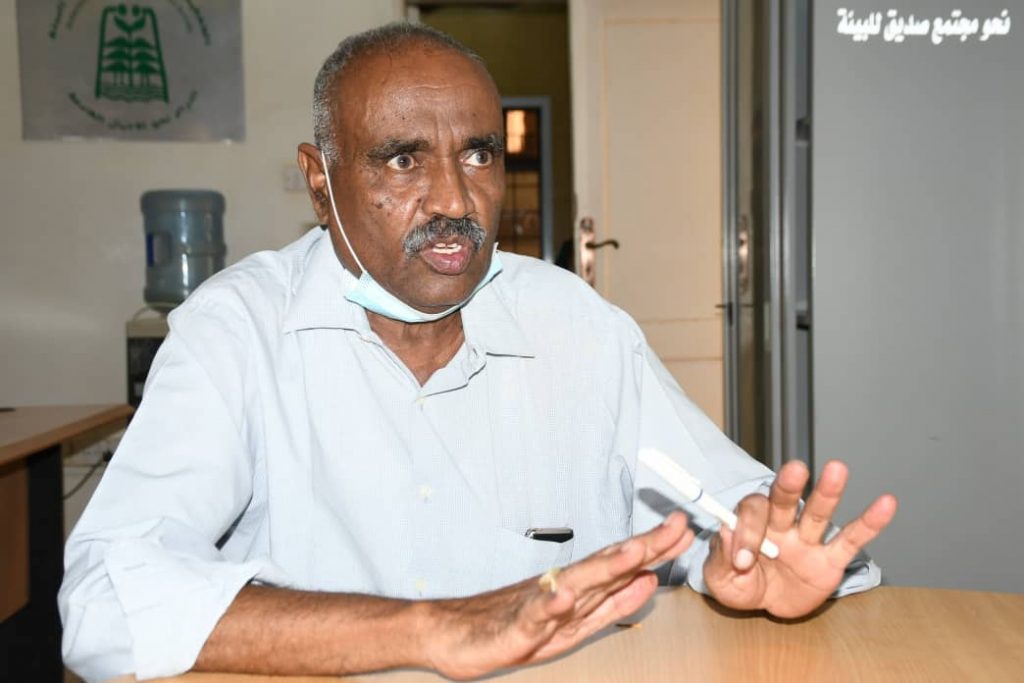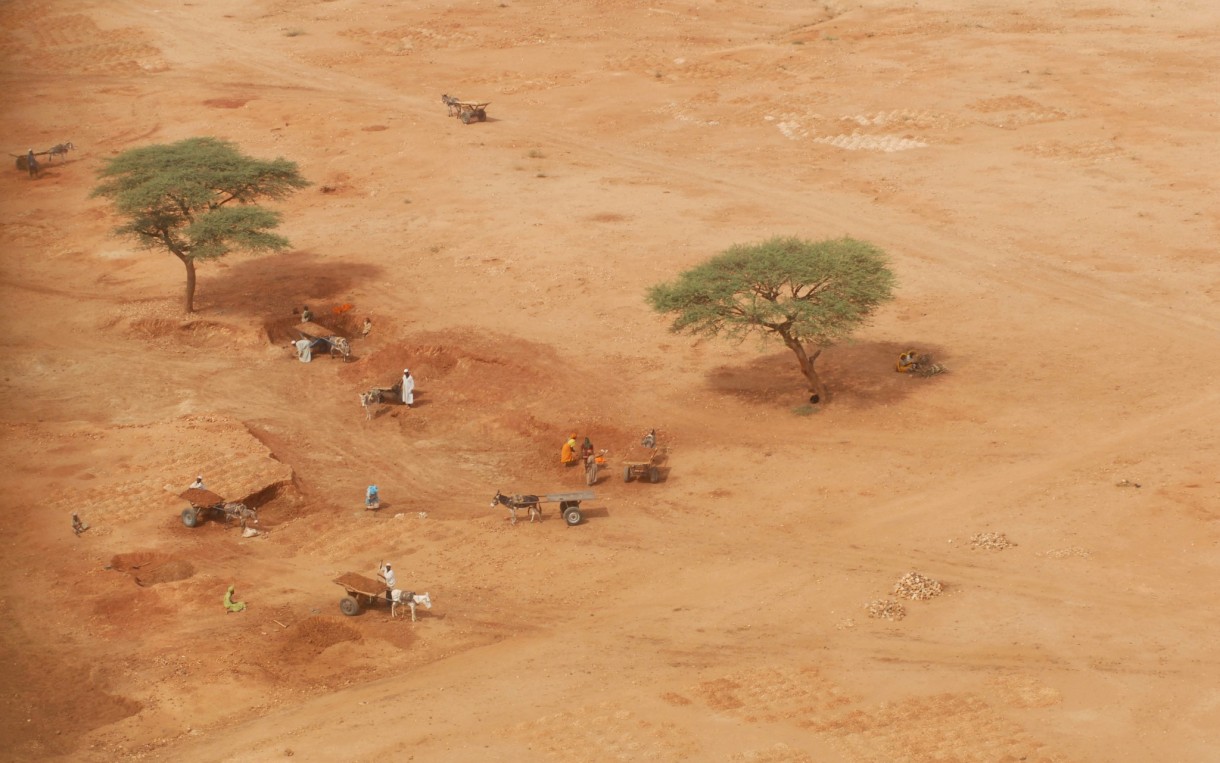Climate change – Darfur’s silent killer
7 January 2021
In the past few years, about six million trees have been cut down in one small municipality in Darfur, a trend tragically replicated in other parts of the region. As a result, observatory bodies have noted increased desertification, land degradation, and subsequent conflict over depleted resources across Darfur. The detrimental effects have been so severe, some Darfur citizens have launched volunteer campaigns calling on authorities to prevent further deforestation from taking place in the region.
Sitting on an elevated patch and overlooking his land in Darfur, western Sudan, fifty-year-old farmer Issa Ali does not know if this year’s harvest will meet his expectations or under-produce, as it has over the past decade. “The soil in this region was rich and produced abundant crops, but now it seems that the entire region is suffering from the effects of climate change,” he observes.
Issa grows beans and cereal in Umm Zaifa in South Darfur. Like millions of others in western Sudan, his livelihood consists of agriculture and herding. He must earn enough to support his family of thirteen.
“The decrease in our yearly harvest worries me,” he says. “One acre of land used to produce about 30 to 40 burlap sacks of beans, but in recent times production has decreased to about 12 to 15 sacks. It is the same for our millet, which has also decreased from 10-20 sacks to 5-10.”
Issa is not the only one to notice the degradation of fertile land in Sudan. According to the Higher Council of Natural Resources, a governmental body designed to protect the country’s environment and natural resources, over the past decade, 12% of arable land has become infertile because of desertification stemming from excessive deforestation.
“Darfur is definitely one of the regions most affected by desertification,” says Dr Mona Abdelhafez, head of the Desertification Department at the Council, adding that the deterioration has spread across agricultural terrain, pastoral grazing routes and forests.
According to the UN’s Food and Agriculture Organisation, the proportion of forest in Sudan has shrunk by 50% in the last 20 years alone. “Entire forests were completely removed in the far south of Darfur. Our observation is that the removal of said forests contributed to climate change and the deterioration of agricultural lands in Darfur,” Abdelhafez told Ayin.
The environmental specialist warns of a potential food shortage in Darfur, especially in the north, where poor rainfall has led to meagre harvests.

Deforestation: a problem the government cannot or will not, handle
Lacking access to other resources, many Darfur residents have contributed to deforestation in the region using wood for cooking or to see as timber. While legislation to counter deforestation exists, authorities remain lenient and rarely enforce, leading to millions of trees being cut down every year across the Darfur region.
Noticing the adverse effects of deforestation on agriculture, some citizens in Darfur have carried out popular campaigns to protect the environment. Residents of Umm Zaifa in Id Al-Fursan, South Darfur, organised a sit-in that began in March 2021 and lasted for more than 45 days. The first of its kind in Darfur, its purpose was to pressure the authorities to prevent the felling of trees.
Ibrahim Zakaria, an environmental activist in Darfur and one of the sit-in organisers, says that about six million trees have been cut down in his municipality of Umm Zaifa, over the last few years, prompting him to act.
“Experts are telling us that the significant decrease of rain in the region, as well as the land degradation and the increase in temperatures, are all linked to deforestation,” he explains. “The aim of the environmental sit-in was to put pressure on the authorities to intervene, apply the deforestation legislation and help locals find alternatives to cutting down trees.”
According to International Monetary Fund statistics, about 47% of the population of Sudan lives below the poverty line. Those figures are even grimmer in Darfur, at 61 percent.
Ahmed Suleiman, a long-time Darfur resident, cites economic hardship as the main spur for deforestation. “Many people completely ignore the effects on the environment while cutting down trees. The state needs to work intensively to raise awareness, apply its own laws and create jobs for young people, to encourage them to abandon the cutting down of trees.”

Changing climate only adds to the competition for resources
Ahmed Al-Sharif, an expert at the Ministry of Agriculture, says rainfall has decreased significantly in Darfur as a result of climate change.
“This year’s autumn season came late and ended early as a result of climate change, and that will greatly affect this year’s harvest,” he explains. “The vast majority of rain in South Darfur mostly comes in early July and ends at the end of September, but in 2021 the rain came in August and ended in mid-September.”
South Darfur State total landmass is roughly 24 million acres, three-quarters of it arable, according to a state official who spoke on condition of anonymity since the official is not authorised to speak to the press. However, only roughly eight million acres is actually used for farming, the same source said. South Darfur State had planned to increase cultivation to more than 10 million acres this year, but due to the lack of rain and land degradation, the official said, that target was not achieved.
Most land in Darfur depends on rain-sustained agriculture, as is the case throughout Sudan, where 93% of the arable land depends on rainwater. In addition to the decrease in rainfall, temperatures are rising all across the country. Climate data from seven meteorological stations across Sudan show that both maximum and minimum temperatures increased everywhere except Khartoum and Kadugli.

The first ‘climate change conflict’
For Ismail El Gizouli, former head of the UN International Professional Committee on Climate Change, the effects of climate change on the troubled region contribute significantly to Darfur’s ongoing conflicts.
“A large part of the Darfur problem came as a result of climatic changes – in fact, the heart of the conflict in Darfur is a dispute over resources. It is clear that as natural resources begin to decrease, the conflict in Darfur exploded,” he said, underlining that climate change is not only an environmental problem but also an economic, social and security problem.
In fact, many researchers have coined the recurrent conflicts in the Darfur region as the “first climate change conflict,” given the convergence of environmental and political factors leading to the ongoing conflict.
While difficult to make direct correlations, research suggests a rise in environmental degradation in Darfur has been a contributing factor to increased conflict between farmers and pastoralists. A security source in the area requesting anonymity says that more than 250 people are killed annually in Darfur due to direct disputes over arable land –a figure he suspects will increase in the years ahead.
In late December, the West Darfur State Doctors Committee said conflicts in three localities over a five-week period within the state caused the death of 148 people. The conflicts, in Jebel Moon, Kerinek and Sirba, were orchestrated attacks, says Ahmed Ishag, a member of the Committee for Stopping Massacres in West Darfur, directly targeting farmers for their land during the harvest season.
But conflict is not the main concern for farmer Issa Ali right now. According to Issa, the long-term environmental degradation in Darfur will make the region virtually un-liveable for everyone if a solution is not identified. “If land degradation and lack of rainfalls continue further,” Ali said, “the economic situation in Darfur will be worse with the vast majority [of its people] totally relying on farming.”
This publication was made possible by the Candid Journalism Grant 2021


